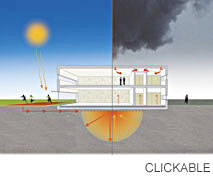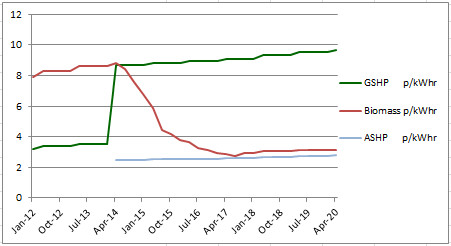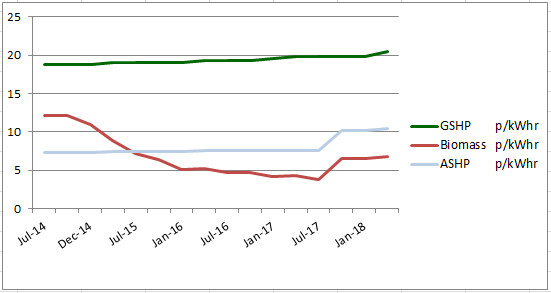
Renewable Heat Incentive rates
9.68 pence/kWh for Commercial RHI - over 20 years
21 pence/kWh for Domestic RHI - over 7 years
Renewable energy grants
"We need to accelerate drastically the pace of the switch to renewables", Greg Barker
Renewable Heat Incentive tariffs have changed over the years

Commercial RHI Tariff for GSHP doubled from May 2014
DECC published its Tariff Review in May 2013 to propose a doubling of GSHP tariffs. This was designed to boost the GSHP market as the number of smaller GSHP commercial installations was only 1% of the number that DECC had anticipated and almost all of the RHI payments were being made to biomass boilers. The increased rates were eventually confirmed by DECC in December 2013 and acknowledged by Ofgem on 28 May 2014.
The RHI tariff table below shows the main technologies eligible for commercial RHI and the subsidy received for new accreditations for each technology. The tariffs are based on pence/kWh of renewable heat delivered from the date of accreditation with Ofgem.
| RHI over 20 years |
Scale in kW | RHI Nov 2011 |
RHI Apr 2012 |
RHI Apr 2013 |
RHI Jul 2013 |
RHI Apr 2014 |
RHI Jul 2014 |
RHI Oct 2014 |
RHI Jan 2015 |
RHI Apr 2015 |
RHI Jul 2015 |
RHI Oct 2015 |
RHI Jan 2016 |
RHI Apr 2016 |
RHI Jul 2016 |
RHI Oct 2016 |
RHI Jan 2017 |
RHI Apr 2017 |
RHI Jul 2017 |
RHI Oct 2017 |
RHI Apr 2018 |
RHI Apr 2019 |
RHI Apr 2020 |
RHI Jul 2020 |
| Solar thermal | up to 200 | 8.5 | 8.9 | 9.2 | 9.2 | 10.0 | 10.0 | 10.0 | 10.0 | 10.16 | 10.16 | 10.16 | 10.16 | 10.28 | 10.28 | 10.28 | 10.28 | 10.44 | 10.44 | 10.44 | 10.75 | 10.98 | 11.12 | 11.12 |
| GSHP | up to 100 | 4.5 | 4.7 | 4.8 | 4.8 | 8.7 | 8.7 | 8.7 | 8.7 | 8.84 | 8.84 | 8.84 | 8.84 | 8.95 | 8.95 | 8.95 | 8.95 | 9.09 | 9.09 | 9.09 | 9.36 | 9.56 | 9.68 | 9.68 |
| GSHP | over 100 | 3.2 | 3.4 | 3.5 | 3.5 | 8.7 | 8.7 | 8.7 | 8.7 | 8.84 | 8.84 | 8.84 | 8.84 | 8.95 | 8.95 | 8.95 | 8.95 | 9.09 | 9.09 | 9.09 | 9.36 | 9.56 | 8.72 | 6.98 |
| ASHP | 0.0 | 0.0 | 0.0 | 0.0 | 2.5 | 2.5 | 2.5 | 2.5 | 2.54 | 2.54 | 2.54 | 2.54 | 2.57 | 2.57 | 2.57 | 2.57 | 2.61 | 2.61 | 2.61 | 2.69 | 2.75 | 2.79 | 2.79 | |
| Biomass | up to 200 | 7.9 | 8.3 | 8.6 | 8.6 | 8.8 | 8.4 | 7.6 | 6.8 | 5.87 | 4.40 | 4.18 | 3.76 | 3.62 | 3.26 | 3.10 | 3.00 | 2.85 | 2.71 | 2.96 | 3.05 | 3.11 | 3.15 | 3.15 |
| Biomass | 200-1,000 | 4.9 | 5.1 | 5.3 | 5.0 | 5.1 | 5.1 | 5.1 | 5.1 | 5.18 | 5.18 | 5.18 | 5.18 | 5.24 | 5.24 | 5.24 | 5.32 | 5.32 | 4.79 | 2.96 | 3.05 | 3.11 | 3.15 | 3.15 |
| Biomass | >1,000 | 1.0 | 1.0 | 1.0 | 1.0 | 2.0 | 2.0 | 2.0 | 2.0 | 2.03 | 2.03 | 2.03 | 2.03 | 2.05 | 2.05 | 2.05 | 2.08 | 2.08 | 2.08 | 2.96 | 3.05 | 3.11 | 3.15 | 3.15 |
RHI rates published by Ofgem – rates change with inflation each year on 1 April.
Rates for RHI have "degressed" (as shown above) for new installations after the dates shown.
Renewable Heat Incentive – Domestic – paid over 7 years

RHI for domestic buildings applied from 9 April 2014 when the Domestic RHI started. Renewable heat installations commissioned since 15 July 2009 can receive RHI of around 19 pence per kilowatt hour used – for the first seven years of the equipment used.
The RHI tariff table below shows the technologies that are eligible for domestic RHI and the rate for each technology. The RHI provides a major incentive for owners to invest in ground source heat pumps and solar thermal renewable heat technologies. The tariffs are based on pence/kWh of renewable heat delivered. The rates vary with the technology used as follows:
| Renewable Heat Incentive Domestic for 7 years |
RHI tariffs p/kWh from Apr14 |
RHI tariffs p/kWh from Jan15 |
RHI tariffs p/kWh from Apr15 |
RHI tariffs p/kWh from Jul15 |
RHI tariffs p/kWh from Oct15 |
RHI tariffs p/kWh from Jan16 |
RHI tariffs p/kWh from Apr16 |
RHI tariffs p/kWh from Jul16 |
RHI tariffs p/kWh from Jan17 |
RHI tariffs p/kWh from Apr17 |
RHI tariffs p/kWh from Jul17 |
RHI tariffs p/kWh from Oct17 |
RHI tariffs p/kWh from Apr18 |
RHI tariffs p/kWh from Apr19 |
RHI tariffs p/kWh from Apr20 |
| Solar thermal | 19.2 | 19.2 | 19.51 | 19.51 | 19.51 | 19.51 | 19.74 | 19.74 | 19.74 | 20.06 | 20.06 | 20.06 | 20.66 | 21.09 | 21.36 |
| GSHP | 18.80 | 18.80 | 19.10 | 19.10 | 19.10 | 19.10 | 19.33 | 19.33 | 19.55 | 19.86 | 19.86 | 19.86 | 20.46 | 20.89 | 21.16 |
| ASHP | 7.3 | 7.3 | 7.42 | 7.42 | 7.42 | 7.42 | 7.51 | 7.51 | 7.51 | 7.63 | 7.63 | 10.18 | 10.49 | 10.71 | 10.85 |
| Biomass | 12.2 | 10.98 | 8.93 | 7.14 | 6.43 | 5.14 | 5.20 | 4.68 | 4.21 | 4.28 | 3.85 | 6.54 | 6.74 | 6.88 | 6.97 |
To receive RHI for a domestic building, each system must be installed by an MCS certified installer.
Each domestic building must show an Energy Performance Certificate to evidence its energy use.
Rates for biomass have "degressed" (as shown above) for new installations after the dates shown.
RHI Tax free income
Tariffs are exempt from income tax. This means that domestic users and other income tax payers will not be taxed on any income received from the Feed-In Tariffs or the Renewable Heat Incentive.
For those using Interseasonal Heat Transfer, the annual clean energy cashback for heating will normally be larger than the annual running cost.
See also: Banking on IHT The Merton Rule Ground Source Energy Economic Renewable Energy
